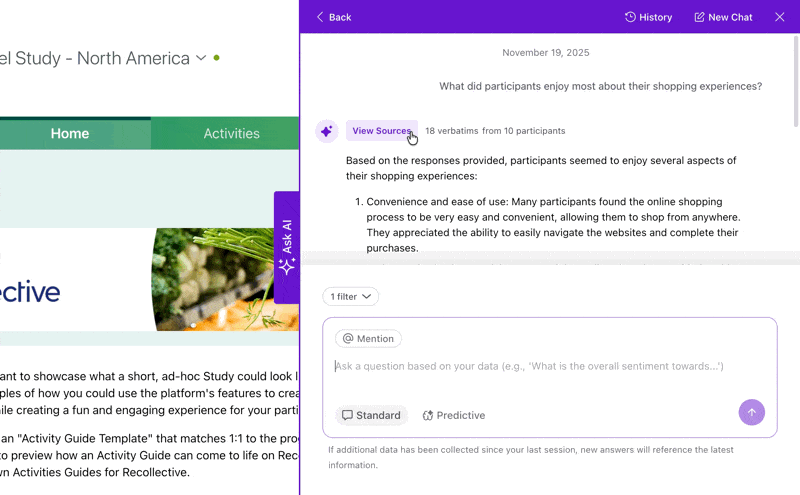Introduction to Ask AI
Ask AI simplifies the shift from data collection to analysis by enabling you to ask open-ended questions directly within your study data, or even across individual studies and multi-market projects on your site. It efficiently processes large volumes of participant responses, delivering AI-generated answers supported by verbatim quotes and ensuring reliable and unbiased insights.
With Ask AI, you reduce the chances of missing critical insights, as it identifies relevant responses to crucial research questions and prioritizes areas for deeper analysis. The feature highlights impactful findings, uncovers unique contributions for exploring unexpected trends, and ensures key participant quotes are included in your final report. This makes the research process more accessible, efficient, and comprehensive, resulting in stronger, more insightful outcomes.
In this article, we'll cover:
- Ask AI Modes
- Using Ask AI: Standard Mode
- Important Notes for Using Ask AI
- Frequently Asked Questions
Ask AI Modes
Once engaged, researchers can utilize Ask AI from three distinct modes:
- Standard Mode: Ask open-ended questions within your study data and receive summarized, data-backed insights with supporting verbatims.
- MultiProject Mode: Explore trends, identify emerging themes, and compare feedback across multiple studies on your site.
- Predictive Mode: Generate predictions about participant sentiment and behaviour to anticipate trends, simulate participant thinking, and test your hypotheses.
While strong in their unique applications, Standard, MultiProject and Predictive modes can also be used in tandem to draw the most from your insights.
Using Ask AI: Standard Mode
As you moderate within your study, Analysts and Moderators will see a purple tab on the right-hand side of the page labelled Ask AI. Once participant responses have been received, Admins can open the tab to set the context of their question.

💡 Ask AI includes data from all task responses in Standard and Journal activities, Live Video Activities, as well as Discussions. This includes:
- All text-based responses
- Audio/Video/Screen/Live Meeting recording transcripts
- Media captions and annotations
- Discussion Topic replies and comments
Filter Data
By default, Ask AI will look across all of the study's responses, but Admins can filter on one or more activities, tasks, Discussion Topics, segments, or participants. Researchers are encouraged to iterate the questions they ask to refine responses.
For example, if you ask a question about responses from a particular Activity or Task, we recommend using the filters to set this context.
- Instead of asking: “What was the most common brand participants mentioned in Activity B?”
- Set the Filter to Activity B, then ask: “What was the most common brand participants mentioned?”
 Use of Mentions
Use of Mentions
Researchers can also leverage @mentions to focus questions on particular participants or segment groups. When a participant or segment is @mentioned, the answer will only include data relevant to those users. This allows researchers to ask more nuanced questions in addition to the filters, such as how the responses from two Segment Groups compare.

- If a Segment filter has been applied, Researchers can only @mention the filtered segments, and mentioning participants will be blocked.
- Similarly, if a Participant filter has been applied, users can only @mention filtered participants, and mentions for segments will be blocked.
As a best practice, we recommend ensuring that all intended users and segments are included in the filters before using @mentions.
Generate an Answer and Asking Follow-Up Questions
See How to Ask Great Questions for tips and best practices on leveraging Ask AI.
Once the question has been submitted, Ask AI will generate an Answer, which can be formatted in several ways, including lists, tables, etc. On this tab, Admins can:

- Provide a rating and share feedback with Recollective
- Copy the Answer
- Ask a follow-up question
When asking follow-up questions, the corresponding answers will be limited to the filters defined in the initial question. Users cannot change the filters within the chat. However, users can leverage @mentions, depending on the applied filters, to focus their follow-up questions on specific participants or segment groups.
Follow-up questions may pertain to previous questions/answers in the chat or be completely unrelated. However, the AI will try to use previous answers as context by default.
Review Verbatims
By clicking on the ‘View Sources’ button, admins can see all of the responses that the AI used to generate that answer. You can review the full response a verbatim was taken from by clicking the ‘Sources’. Verbatims from live video activities will also contain AI-generated context to offer insight into the topic leading up to each verbatim.

Each verbatim is rated by its relevance to the answer, which is indicated by a score of 1 to 4. Each score is defined below:
- Highly Relevant (●●●●): The verbatim is very relevant and directly supports the answer.
- Relevant (●●●): The verbatim is relevant and contributes to the answer.
- Slightly Relevant (●●): The verbatim was considered in forming the answer, but may not be directly referenced.
- Low Relevance (●): The verbatim was used in generating the answer, but may not relate to the final answer.
While verbatims sourced from the same participant's response are grouped by default, you may also opt to list sources individually instead.
Chat History
Admins will also see options to create a New Chat or access previous questions saved in the chat History to keep track of their previous question threads. Each historical chat will be labelled by the first question asked within the chat. Upon entering a historical chat, users can continue asking questions where they left off.

Important Notes for Using Ask AI
Ask AI is a powerful tool designed to enhance your data analysis experience. While we are constantly improving our AI to serve you better, here are some key points to keep in mind:
- Data Inclusion: Data collected before the availability of this feature may not be included in the analysis. For affected studies, the timeframe of included data will be identified within the Ask AI panel from your study.
- Verbatim References: The AI may list some verbatims that informed the response, even if they are not directly mentioned in the answer.
- Accuracy: While Ask AI aims for high accuracy, it may occasionally make errors. Your feedback is crucial in helping us refine and improve this feature.
Frequently Asked Questions
For questions surrounding Recollective AI data security, please refer to Recollective AI: Privacy & Data Security FAQ.
- Which Task types should I use to leverage Ask AI?
Ask AI will support any task type that includes text responses, transcripts, or captions. As the AI cannot currently analyze visual media, ensure that participants provide photo responses with accompanying text captions and video responses that can be transcribed. - Does Ask AI offer real-time analysis?
Yes! New responses will be included to generate answers. This will allow you to ask questions as data comes in or after the study is complete. - Can I ask AI questions about frequencies or omissions in my data? Ex. “How many participants said…” or “Which brands weren't mentioned…”
The Ask AI feature is less suited for direct quantitative queries, such as counting mentions, as it is primarily designed to assess open-ended responses. The Ask AI feature is unable to answer questions about missing data. We recommend focusing on what is included rather than what isn't for accurate results. - Why do I see the message: “We were unable to match relevant sources to your question” after submitting my question?
Recollective ensures that responses are provided only when sufficient relevant information is available from the study. If a question is asked and there are no sources or not enough data to support a finding, Recollective AI will notify the researcher of this shortfall. In such cases, researchers can reframe their question or choose to relax any filters being applied, such as removing filters on activity, task, or segment. - Is there a limit to the number of questions I can ask?
Each chat can receive up to 50 questions in total. Once you reach this limit, the chat will be disabled, and you will be prompted to start a new one. However, there is no limit to the number of chats you can initiate. - Does Ask AI support other languages?
Yes! Ask AI can generate answers in any of our supported languages, regardless of the study’s default settings. For better language detection, ask longer, more detailed questions. Short questions with words common to multiple languages can confuse the AI and result in responses in the wrong language. -
Does Ask AI recognize participants’ names in a question?
For privacy reasons, the AI doesn’t store or know participants’ names. The @mentions function converts names into values the AI can associate with specific users. For example, if you type "Kevin Parker," the AI won’t know who you're referring to unless you use the @mention. - Why does the banner say “All activities created after [Date] will be included” when I can still ask questions for activities created before this date?
The banner shows the standard cutoff date for most activity data. However, if you have previously requested historical data ingestion for your site, older activities may also be available for questions.
For ideas on what questions you can ask, see our article: How to Ask Great Questions.

 Use of Mentions
Use of Mentions